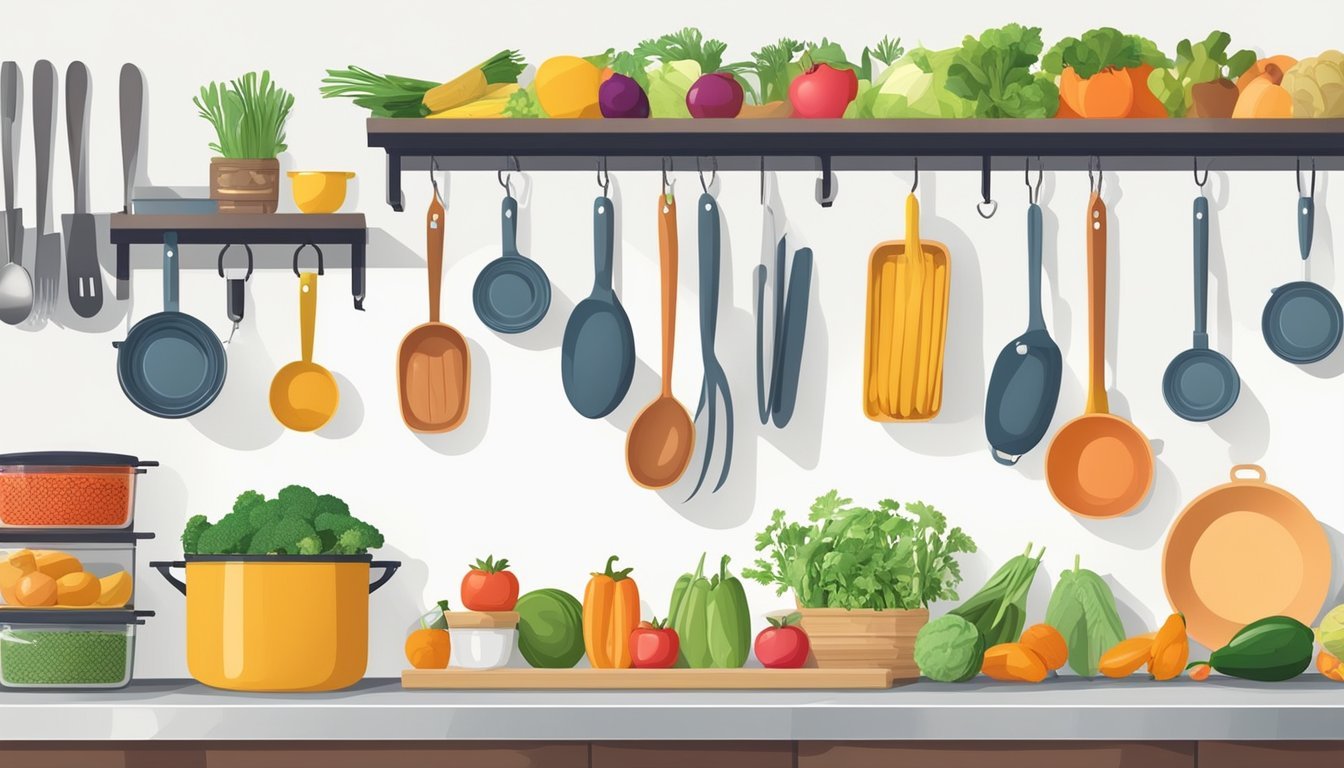The Ultimate Guide to Organizing Your Kitchen for a Feingold Diet
Streamlined Strategies and Tips
Embarking on the Feingold Diet requires careful planning and organization, especially when it comes to the kitchen. This dietary plan not only eliminates certain food coloring and preservatives but also looks at natural substances called salicylates. Organizing the kitchen is a pivotal step in ensuring the success of this diet, helping individuals, particularly those with children with ADHD or food sensitivities, to adhere to the guidelines effortlessly.
The kitchen is the heart of any diet transformation. For the Feingold Diet, it becomes essential to have a space that supports this specific nutritional approach. Removing foods and additives that are not compliant with the diet is just the beginning. It also involves stocking up on whole, nutrient-dense foods like fruits, vegetables, whole grains, lean proteins, and healthy fats. Having these items accessible and properly stored can make meal preparation simpler and help maintain the diet's integrity.
Understanding the Feingold Diet
The Feingold Diet is a structured eating plan developed by Dr. Benjamin Feingold to address various health and behavioral concerns. It centers around the elimination of certain additives and foods from an individual’s diet.
History of the Feingold Diet
Dr. Benjamin Feingold, a respected pediatrician and allergist, introduced the Feingold Diet in the 1970s. Initially, it was implemented to treat children with allergies, but later extended to those with ADHD, as it became evident that certain food additives appeared to exacerbate behavioral problems.
Principles of the Feingold Diet
At the heart of the Feingold Diet are two core components:
Elimination of Synthetic Additives:
Artificial colors
Artificial flavors
Preservatives
Avoidance of Natural Substances:
Salicylates found in a variety of fruits, vegetables, and other plant-based foods.
The diet advocates for natural, unprocessed foods and emphasizes the importance of whole foods like fruits, vegetables, whole grains, lean proteins, and healthy fats.
Scientific Evidence and Effectiveness
Scientific research on the Feingold Diet's effectiveness has been mixed. Studies have shown that a segment of individuals, particularly children with ADHD, may exhibit improved behavior when following the diet. However, the diet does not have universal efficacy, and the extent of its benefits can vary widely among individuals.
Behavioral Conditions:
ADHD
Hyperactivity
Eczema
Asthma
Other behavioral problems
While some parents and healthcare providers report success with the Feingold Diet, mainstream scientific evidence remains inconclusive, and further research is necessary to verify its overall effectiveness.
Identifying Feingold-Friendly Foods
When organizing your kitchen for the Feingold Diet, it's essential to distinguish between foods and products that comply with the program's guidelines and those that don't. This section helps identify Feingold Diet-approved items and understand the intricacies of food labels.
Approved Foods and Substances
Approved foods within the Feingold Diet consist of a variety of natural ingredients that exclude harmful additives and preservatives. Safe options include:
Fruits & Vegetables: Most fruits and vegetables, except those high in salicylates.
Grains: Whole grains without artificial additives.
Protein Sources: Fresh meats and non-processed protein options.
Dairy: Milk, butter, and cheese without artificial flavors or colors.
Seek guidance from the Feingold Association or a healthcare provider for a comprehensive list of approved foods.
Understanding Food Labels
Food labels are your roadmap to identifying noncompliant ingredients. Here is a breakdown:
Colors and Dyes: Look for names like Yellow No. 5 or Red No. 40 and avoid these products.
Artificial Sweeteners: Aspartame, saccharin, and other synthetic sweeteners must be avoided.
Preservatives: BHA, BHT, and TBHQ are common preservatives to stay away from.
Salicylate Foods to Avoid
Salicylates are naturally occurring chemicals that can be problematic for some individuals on the Feingold Diet:
High-Salicylate Fruits: Apples and grapes are high in salicylates.
Vegetables: Tomatoes also contain higher amounts of salicylates.
It's recommended to seek out low-salicylate alternatives initially.
Non-Food Items to Consider
The Feingold Diet also extends beyond food to include everyday items due to the presence of additives and fragrances:
Medications: Aspirin and certain medicine containing aspirin should be avoided, as they contain salicylates.
Household Products: Fragrances, cleaning products, and other items containing artificial scents are unsuitable.
Always consult with a healthcare provider before making changes to medication or for alternatives to household items with additives and fragrances.
Planning and Preparing Your Pantry
Preparing one's pantry on the Feingold Diet emphasizes the importance of eliminating additives, artificial flavors, and colors, which often involves the meticulous selection and organization of food items. It requires a structured approach to not only what one stocks in their pantry but also how items are stored and labeled.
Stocking Feingold Diet Staples
When adopting the Feingold Diet, the pantry must be stocked with whole, unprocessed foods that are free of synthetic additives. Foods such as fresh fruit, an array of spices, and a variety of nuts are key staples. It's essential to choose cereal that is free of artificial colors and flavors, and snacks which contain natural sugars. For preparation of meals, having recipes that utilize these ingredients and adhere to the diet's guidelines is crucial. Below is a concise list of staples to consider:
Fruits: Apples, pears, and berries (avoiding those with prohibited substances)
Vegetables: Fresh or frozen without added colors or sauces
Whole grains: Brown rice, quinoa, certified gluten-free oats if required
Spices: Pure, additive-free spices for seasoning
Nuts: Unsweetened and unflavored varieties
Dry goods: Beans, lentils, and flour (gluten-free if necessary)
Labeling and Storage Solutions
Effective labeling and storage play a pivotal role in maintaining a pantry congruent with the Feingold Diet. Clear labelling helps to avoid any confusion about the contents and their suitability for the diet. Utilizing glass jars and bins can not only enhance the longevity of food but also offers a visual inventory of available items. Consider marking jars and containers with bold labels reflecting content and expiration dates. Cost-effective organization tips suggest repurposing items and using uniform storage for ease of management. Here is a suggested setup:
Glass Jars: Used for storing spices, nuts, and dry goods to preserve freshness and facilitate quick identification
Bins/Baskets: Ideal for grouping similar items such as packets of gluten-free flour or rice varieties, which helps in preventing cross-contamination
Organizing a pantry tailored to the Feingold Diet requires intentionality in both selection and presentation. One should select staples carefully and implement a storage solution that suits a healthy, minimal-additive lifestyle.
Kitchen Organization for Feingold Diet
Proper organization is essential for adhering to the Feingold Diet, which eliminates artificial additives. One's kitchen must be arranged meticulously to facilitate easy identification and accessibility of Feingold-friendly foods and cookware, thereby ensuring a smooth cooking process.
Arranging Pots, Pans, and Appliances
Pots and Pans: For the Feingold Diet, specific pots and pans may be dedicated to preparing additive-free meals. Such cookware should be stored near the cooking area for ease of access. For instance:
Pots: Keep a stack of various sizes in lower cabinets, with the most frequently used sizes on top.
Pans: Organize in a rack or hang them if possible, sorted according to type and frequency of use.
Appliances: Kitchen appliances that aid in preparing whole foods are paramount. A microwave, for example, can be helpful but should be placed so that it doesn't dominate counter space. Consider arranging smaller appliances like blenders or food processors in easily accessible cabinets or on appliance garages that can be kept on the countertop for regular use.
Blenders/Food Processors: Store in a cabinet with pull-out shelves.
Microwave: Position on a shelf that doesn't crowd the main prep area.
Storage Tips for Refrigerator and Freezer
Refrigerator: One's fridge should highlight Feingold-approved ingredients. To accomplish this:
Create sections with clear, labeled bins for fruits, vegetables, and permitted snacks.
Dedicate a specific shelf to foods commonly used in the Feingold Diet, like preservative-free dairy products.
Freezer: Organizing the freezer assists in the long-term storage of Feingold-friendly foods and helps avoid cross-contamination. Suggestions include:
Use sliding bins or baskets to categorize Feingold-approved frozen produce and meats.
Reserve a particular area for homemade meals that conform to the diet's guidelines.
By applying these organization strategies, individuals on the Feingold Diet can maintain a kitchen that complements their dietary choices, making meal preparation straightforward and stress-free.
Cooking and Meal Preparation
When adopting the Feingold Diet, one must revamp their kitchen practices to ensure that all meals are free from artificial additives and salicylates. Cooking techniques and ingredient substitutes require precise adjustments to adhere to the diet's guidelines.
Feingold-Friendly Cooking Techniques
Individuals following the Feingold Diet should focus on cooking methods that maintain the integrity of food while avoiding the addition of prohibited substances. For breakfast, steaming or poaching eggs is preferable to frying, which might involve non-compliant oils. Dinner preparations can involve grilling or baking with careful attention to spices; herbs such as garlic and chives are Feingold-approved. Cooks should utilize utensils made from natural materials like wood or stainless steel to prevent contamination from plastics that might leach additives.
Utensils to use:
Wooden spoons
Stainless steel spatulas
Glass measuring cups
Culinary processes like fermenting or pickling are to be conducted using Feingold-safe ingredients, such as vinegar derived from allowed sources—not corn or apple—and incorporating Feingold-friendly spices.
Substituting Ingredients in Recipes
Successful adherence to the Feingold Diet in baking and cooking requires careful substitution of non-compliant ingredients. In recipes calling for sweeteners, one should replace sugar with stevia, a natural alternative. Baking soda, which is permitted, often becomes a leavening agent of choice in place of baking powder that may contain artificial additives.
Non-Feingold Ingredient Feingold-Friendly Substitute Sugar Stevia Artificial Sweeteners Honey, Maple Syrup Dairy Rice Milk, Coconut Milk Artificial Coloring Natural Food Dyes
It is pivotal to organize the pantry and cooking utensils thoughtfully, grouping approved ingredients together to simplify meal prep. Water, free of additives or flavors, should be the primary liquid used in cooking, though fresh juices from allowed fruits are also acceptable for added flavor in various recipes.
Dining Out and Social Challenges
When following a Feingold Diet, dining out and attending social events can pose unique challenges. Individuals must be vigilant in avoiding additives and artificial ingredients that are prevalent in many restaurant dishes and party snacks.
Choosing Feingold-Friendly Restaurants
When selecting a restaurant, individuals should look for venues that prioritize fresh, whole foods with minimal processing. It is beneficial to consult restaurant menus in advance and identify which dishes are likely to conform to the Feingold Diet guidelines. Calling ahead and speaking with the chef can provide clarity on the use of potential additives.
Research: Look for restaurants specializing in organic or natural cuisine as they are more likely to accommodate the Feingold Diet.
Communication: Inform the restaurant staff of specific dietary requirements to avoid ingredients that are not Feingold-approved.
Navigating Social Gatherings
Social gatherings often involve a variety of foods and snacks that may not align with the Feingold Diet principles. Parents and adults can bring their own Feingold-compliant dishes to share, ensuring there is something safe to eat.
Preparing Ahead: Bring your own snacks or a dish to gatherings, which not only helps the host but also ensures adherence to the Feingold Diet.
Offers and Invitations: Politely decline offerings that don't meet diet requirements and be prepared with a brief explanation to satisfy any curious hosts or guests.
For both restaurants and social events, individuals with allergies or sensitivities should always be prepared with a list of ingredients to avoid and be ready to inquire about them. Carrying personal snacks or drinks that are safe can alleviate the difficulty of finding suitable options while away from home.
Lifestyle Considerations and Support
Adapting to the Feingold Diet requires thoughtful organization within the kitchen and an understanding of how this change will integrate into one's lifestyle. This section provides practical guidance for incorporating the diet into daily routines and underscores the importance of community support.
Incorporating the Feingold Diet into Your Lifestyle
The Feingold Diet necessitates meticulous planning and aliment organization, particularly for individuals with autism or those experiencing behavioral problems, such as hyperactivity and dyslexia. Parents can start by categorizing food items according to Feingold guidelines and clearly labeling storage areas. Below is a simple framework to consider:
Initial Setup: Dedicate different shelves or containers for Feingold-approved items.
Meal Planning: Create weekly menus that align with dietary requirements to streamline shopping and preparation.
Finding Community and Support
Support from others following the Feingold Diet can be invaluable, particularly for families new to this lifestyle. Parents often benefit from the shared experiences and tips for managing behavior linked to food sensitivities. To aid this journey:
Feingold Association: Engage with this resource for recipes, research, and local support groups.
Online Communities: Participate in forums and social media groups where members exchange advice and encouragement.
By establishing clear kitchen organization principles tailored to the Feingold Diet and leveraging the collective knowledge and support of the community, families can navigate dietary changes more confidently.
Practical Tips for Parents
Maintaining a Feingold Diet demands careful kitchen organization and clarity for all family members. These tips provide foundational steps to educate children about their dietary needs and create an environment that supports those needs.
Educating Children on the Feingold Diet
Parents should initiate open discussions with their children to explain the Feingold Diet's principles and its benefits. It's crucial to convey that avoiding certain additives and artificial colorings can help improve their behavior and focus. Parents can use visual aids, like charts or color-coded tables, to illustrate which foods are Feingold-approved and which are not. For example:
Feingold-Approved Avoid Fresh fruits Artificial colorings Most vegetables Artifical flavorings Whole grains Preservatives Natural snacks Aspartame
Engaging children through interactive learning, such as preparing Feingold-friendly snacks together, reinforces these lessons and empowers them to make informed dietary choices.
Creating a Supportive Kitchen Environment
Once children understand the basics of the Feingold Diet, organizing the kitchen to support their choices is essential. Parents can designate specific baskets or shelves for Feingold-approved snacks and desserts, ensuring they are at a reachable height for children. Labels and color-coding can further aid in this endeavor, with bold and clear signage to prevent confusion.
Drawer organizers can be used to separate permitted and non-permitted items, while hooks near the sink can hold reusable bags containing Feingold-approved items for school lunches. Parents need to ensure that these organizational systems are consistently followed, turning the kitchen into a safe and supportive space that fosters dietary adherence without unnecessary stress or temptation.
Budgeting and Managing Costs
Organizing a kitchen to comply with a Feingold Diet involves mindful planning and budget management, particularly when it comes to avoiding foods with salicylates and artificial additives. Adopting effective cost-saving strategies is key for maintaining the diet without overspending.
Cost-Saving Strategies for the Feingold Diet
Plan Your Purchases:
Create Lists: They should mark clearly which items are Feingold Diet-friendly, focusing on avoiding products that contain artificial flavors, colors, and preservatives, as well as high-salicylate foods.
Bulk Buying: Choose bulk options for Feingold-approved staples to save money in the long run.
DIY Solutions:
Cook from Scratch: Making your own meals can be significantly less expensive than buying pre-packaged ones, which often contain non-Feingold ingredients.
Home Gardens: Consider growing vegetables and herbs that fit within the Feingold parameters.
Smart Shopping:
Compare Prices: Check multiple stores and online options for the best deals on Feingold-approved products.
Use Coupons: Keep an eye out for discounts and coupons on suitable food items and kitchen organization tools.
Kitchen Organization:
Repurpose Containers: Reuse jars and containers to store bulk Feingold Diet comestibles, keeping an organized pantry that's both cost-effective and compliant.
Effective Storage Solutions: Invest in cost-effective storage solutions that make the most of your kitchen space, ensuring that Feingold-friendly products are easily accessible and well-preserved.
By incorporating these strategies, individuals can manage their budget effectively while adhering to the Feingold Diet.
Long-Term Maintenance and Adaptation
Maintaining an organized kitchen is essential for adhering to the Feingold Diet long-term. It ensures that individuals can easily identify suitable food items and makes meal preparation more efficient.
Sustaining the Feingold Diet Over Time
Organizing for the Feingold Diet requires a clear understanding of which foods are permissible. Individuals should ensure that shelves and storage areas are categorized to separate Feingold-friendly items from those that are not allowed.
Labels: Clearly label shelves and storage bins with Feingold-approved food categories. This helps adults and children alike in making correct food choices consistently.
Inventory: Regularly update an inventory list to track what items are in stock. This can be managed digitally or with a simple kitchen whiteboard.
Kitchen Zones: Create specific zones for cooking and food preparation, with easy access to Feingold Diet recipes and ingredients. Organize the layers as follows for ease of access:
Dry goods: Store in transparent, labeled containers to quickly find rice, grains, and flour.
Snack area: Keep Feingold-approved snacks at eye level for kids in a designated "snack zone."
Cooking station: Group all cooking essentials like spices and cooking oils within reach of the stove.
Tools and Resources:
Recipe Books: Place Feingold Diet recipe books on an easily accessible shelf to inspire meal prep and variety.
Apps and Trackers: Use apps to monitor adherence to the diet and to access a broad database of Feingold-friendly recipes.
Restocking:
Automated Lists: Utilize grocery list apps that allow for quick restocking of items running low.
Feingold Products: Subscribe to updates from Feingold product providers to keep informed about new items or changes in product status.
Staying Informed:
Information Sharing: Attend workshops, webinars, or community groups that share tips and ideas about living with the Feingold Diet.
Literature: Keep a mini library of relevant nutrition books to understand the importance of diet maintenance.
Lifestyle Integration:
Incorporate the diet into the family’s culture by having everyone participate in organizing and meal prepping. This reinforces the diet as a normal part of daily life.
By employing these practices, an individual can ensure their kitchen supports their adherence to the Feingold Diet with confidence and ease, providing a structured foundation for a lifestyle that consistently aligns with their dietary goals.












